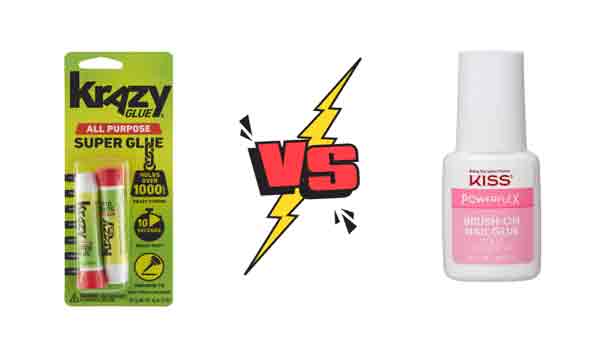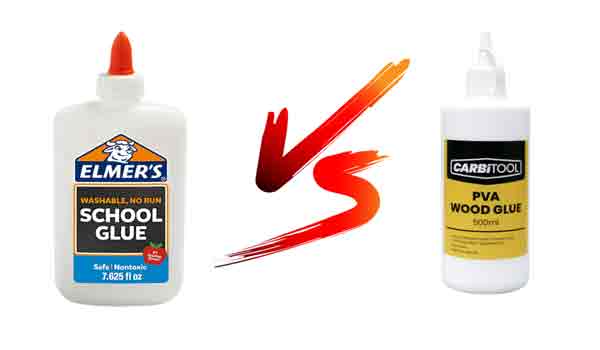Wood Glue Vs Super Glue: Composition, Bonding Properties & More
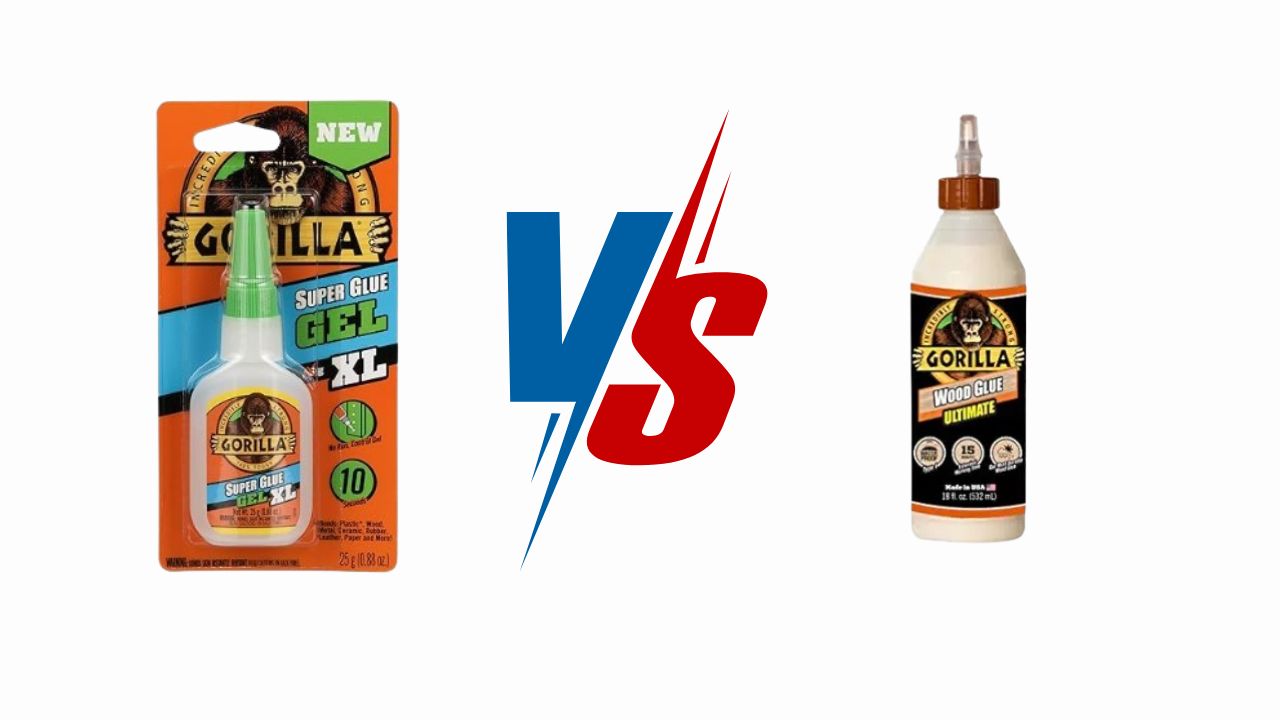
1. Wood Glue:
- Best for: Porous materials like wood, paper, cardboard, fabric.
- Strengths:
- Strong bond, especially after clamping.
- Fills gaps and uneven surfaces.
- Dries clear or slightly opaque.
- Generally waterproof (depending on type).
- Easier to remove from surfaces than super glue.
- Weaknesses:
- Slower drying time (usually 20 minutes to several hours).
- Requires clamping for strong bond.
- Not suitable for non-porous surfaces like metal or glass.
2. Super Glue (Cyanoacrylate Glue):
- Best for: Non-porous materials like metal, plastic, ceramic, rubber, and some woods.
- Strengths:
- Bonds instantly, no clamping needed.
- Very strong bond.
- Works on small surfaces.
- Weaknesses:
- Brittle bond, prone to cracking under stress.
- Doesn’t fill gaps well.
- Not waterproof.
- Difficult to remove from surfaces.
- Fumes can be irritating.
What Is The Difference Between Super Glue And Wood Glue?
Here’s a table summarizing the key differences:
| Feature | Super Glue | Wood Glue |
| Chemical composition | Cyanoacrylate | Polyvinyl acetate (PVA) |
| Setting time | Seconds/minutes | 30 minutes – several hours |
| Water resistance | Varies, not ideal for prolonged water exposure | Water-resistant or waterproof options available |
| Porous materials | Not ideal | Works well with porous materials |
| Applications | Quick repairs, small fixes, dissimilar materials | Woodworking projects, furniture repairs, wood bonding |
Here’s a quick decision guide:
Use wood glue for:
- Woodworking projects.
- Projects requiring strong, long-lasting bonds.
- Filling gaps and uneven surfaces.
- Water-resistant applications.
Use super glue for:
- Quick repairs.
- Bonding small, non-porous surfaces.
- When clamping is impractical.
Wood Glue: Find your One
| Features | Gorilla Wood Glue | Titebond III Ultimate Wood Glue |
| Chemical Composition | Polyvinyl acetate (PVA) | Proprietary formula |
| Setting Time | 20-30 minutes clamp time, fully cured in 24 hours | 30-minute clamp time |
| Water Resistance | Waterproof (ANSI/HPVA Type 1) | Water-resistant, provides water cleanup while wet |
| Indoor/Outdoor Use | Indoor and outdoor versatility | Versatile for various woodworking projects |
| Strength | Incredibly strong bond | Much stronger bond than the wood itself |
| Sanding Ease | Not specified | Excellent heat-resistance, easy to sand |
| Cleanup | Water cleanup while still wet | Water cleanup while glue is wet |
| Initial Tack | Strong initial tack | Strong initial tack |
| Toxicity | Not specified | Non-toxic (ASTM D4236 compliant) |
| Clamp Time | 20-30 minutes | 30 minutes |
| Check Price | Check Price | Check Price |
1. Gorilla Ultimate Waterproof Wood Glue: Build with Confidence, Rain or Shine
Forget the frustration of flimsy wood joints and failed repairs. Introducing Gorilla Wood Glue Ultimate, the powerhouse adhesive that conquers even the toughest projects.
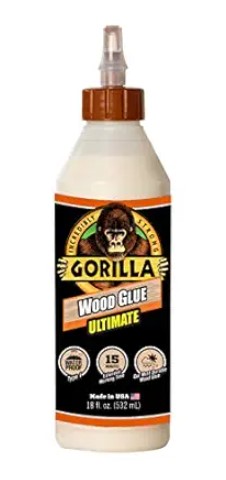
- Strength Unmatched: This isn’t your average wood glue. Imagine bonds so strong they laugh in the face of water, sun, and even extreme temperatures. Build outdoor furniture, decks, or anything exposed to the elements with unwavering confidence.
- Work Smarter, Not Harder: Enjoy a generous 15-minute open time to adjust and position your pieces perfectly. No more rushed gluing or misaligned joints. Plus, say goodbye to stubborn cleanup – this water-based formula washes away easily with just a damp cloth.
- Speed and Durability, Hand in Hand: Clamp for just 20-30 minutes, and your project is ready to handle anything. Gorilla Wood Glue Ultimate cures completely in 24 hours, delivering a rock-solid bond that won’t let you down.
- Beyond Wood: Don’t limit yourself! This versatile glue tackles a variety of materials, including paper, cardboard, and even some fabrics. Unleash your creativity and tackle any project with ease.
Build with confidence, build with Gorilla Wood Glue Ultimate.
Key Benefits:
- 100% waterproof and incredibly strong
- Extended 15-minute working time
- Fast 20-30 minute clamp time
- Fully cured in 24 hours
- Easy water cleanup
- Versatile for various materials
Applications:
- Outdoor furniture and decks
- Woodworking projects
- Repairs and renovations
- Crafts and hobbies
- And much more!
2. Titebond III Ultimate Wood Glue: Building Bonds Stronger Than Wood Itself
When it comes to wood projects, you need a glue that goes beyond holding. Enter Titebond III Ultimate Wood Glue, a champion of strength, versatility, and peace of mind.

- Strength You Can Trust: Forget worrying about weak joints and failed repairs. This glue forms bonds that are stronger than the wood itself, defying stress and everyday wear. Imagine crafting heirloom furniture or outdoor structures that stand the test of time, built with unwavering confidence.
- Heat Won’t Melt Your Masterpiece: Unlike some glues, Titebond III Ultimate laughs in the face of heat. Its exceptional heat-resistance makes it perfect for projects exposed to warmer climates or even heated floors. Craft anything from windowsills to outdoor planters without fear of warping or weakening bonds.
- Smooth Sailing for Sanding: Sanding glued joints can be a nightmare. But not with Titebond III Ultimate. Its unique formula ensures smooth, effortless sanding, leaving a flawless finish that complements your woodworking artistry. No more uneven surfaces or unsightly glue residue to mar your masterpiece.
- Water Clean Up, No Sweat: Accidents happen, especially when working with glue. But with Titebond III Ultimate, cleanup is a breeze. Its water-based formula allows you to easily wipe away spills or mistakes while the glue is still wet. No harsh chemicals, no lingering fumes, just a clean workspace and peace of mind.
- Strong Start, Lasting Finish: This glue boasts a strong initial tack, ensuring your pieces stay securely in place while you work. Plus, its 30-minute clamp time provides ample flexibility for adjustments before the bond sets permanently. You can work confidently, knowing your project will be held together with unwavering strength.
- Safety First, Creativity Always: Titebond III Ultimate prioritizes your well-being. It conforms to ASTM D4236, meaning it’s non-toxic and safe for use, making it ideal for crafting with family or working on projects around children and pets.
- Beyond Wood, Endless Possibilities: Don’t limit yourself! While perfect for wood, this glue also excels with paper, cardboard, and even some fabrics. Unleash your creativity and tackle a variety of projects with confidence.
Build your dreams, build with Titebond III Ultimate Wood Glue.
Key Benefits:
- Stronger bonds than wood itself
- Excellent heat-resistance
- Easy sanding
- Water cleanup while wet
- Strong initial tack and 30-minute clamp time
- Non-toxic and safe to use
Applications:
- Woodworking projects of all kinds
- Outdoor furniture and structures
- Crafts and hobbies
- Repairs and renovations
Read More About A Comprehensive Guide On Does Super Glue Work On Wood
Wood Glue Vs Super Glue: Comparison
Here’s a comprehensive comparison:
1. Chemical Composition
- Wood Glue: Primarily composed of polyvinyl acetate (PVA), offering flexibility and good adhesion to wood fibers.
- Super Glue: Mainly consists of cyanoacrylate (CA), forming rapid and rigid bonds between various materials.
2. Setting Time
- Wood Glue: Sets slower, typically taking 30 minutes to several hours for complete curing, allowing for adjustments during application.
- Super Glue: Sets extremely fast, usually within seconds or minutes, requiring precise placement and quick action.
3. Bond Strength
- Wood Glue: Provides a strong and durable bond, specifically designed for wood-to-wood bonding.
- Super Glue: Offers strong adhesion to various materials like metal, plastic, and rubber, but the bond might be brittle on wood due to its rigidity.
4. Water Resistance
- Wood Glue: Many types are water-resistant, and some are even waterproof, making them suitable for outdoor applications.
- Super Glue: Varies depending on the specific type, but generally not ideal for prolonged water exposure.
5. Porous Materials
- Wood Glue: Works well with porous materials like wood as it fills the pores and creates a strong mechanical bond.
- Super Glue: Not ideal for highly porous materials like wood as it can seep into the pores and weaken the bond.
6. Temperature
- Wood Glue: Generally between 50°F (10°C) and 70°F (21°C). Most wood glues become less effective below 50°F.
- Super Glue: Generally between -55° to 100° C.
7. Shelf Life
- Wood Glue: Can last up to 2 years or more, depending on the brand and storage conditions.
- Super Glue: Typically has a shelf life of 1-2 years.
8. Applications
- Wood Glue: Ideal for woodworking projects, furniture repairs, and any application requiring a strong, long-lasting bond for wood.
- Super Glue: Best suited for quick repairs, small fixes, and bonding dissimilar materials.
What Is Wood Glue Used For?
- Furniture assembly and repairs: Joining furniture components, repairing loose joints, and fixing cracks or broken pieces.
- Cabinet making and carpentry projects: Creating strong bonds for cabinets, shelves, drawers, and other structural elements.
- Veneering and laminating: Applying veneers or laminates to surfaces for decorative or functional purposes.
- Woodcraft and hobby projects: Creating decorative items, models, and other intricate wood projects.
Types Of Wood Glue
Here are the most common types:
1. Polyvinyl Acetate Glue
Also known as white glue or carpenter’s glue, PVA glue is the most common type of wood glue. It is water-based, non-toxic, and relatively inexpensive.
2. Aliphatic Resin Glue
Aliphatic resin glue is a good choice for outdoor projects or applications where the glue may come into contact with moisture.
3. Polyurethane Glue
A strong and versatile glue that is both water-resistant and solvent-resistant. However, it can be more difficult to clean up than other types of wood glue.
4. Epoxy Glue
Epoxy glue is a good choice for high-strength applications, such as boat building or repairing cracks in furniture.
5. Hide Glue
A traditional type of wood glue made from animal collagen. Hide glue is reversible, meaning it can be softened with heat and water, which can be useful for repairs.
Read Also Does Super Glue Work On Metal : A Strong and Durable Adhesive Connection
Can I Add Water To Wood Glue?
You can add a small amount of water (up to 5%-10%) to thin thickened wood glue, but avoid it for regular use as it weakens the bond.
What Is Wood Glue Made Of?
Wood glue is typically made of polyvinyl acetate (PVA), a synthetic resin. It’s also commonly known as white glue or carpenter’s glue.
PVA glue is water-based, non-toxic, and relatively inexpensive. It is strong and dries clear, making it ideal for general woodworking applications.
How Long Does Wood Glue Last?
Unopened wood glue lasts up to 2 years or more, while opened glue stays usable for 1-2 years with proper storage.
What Is The Advantage Of Wood Glue?
Wood glue’s key advantages lie in its:
- Strong & durable bonds: Creates long-lasting unions, often exceeding wood’s strength.
- Porous material compatibility: Fills wood pores for a powerful mechanical bond.
- Water resistance options: Many types offer water resistance or even waterproofing for outdoor use.
- Ease of use: User-friendly with various forms, easy application, and adjustable setting time.
- Versatility: Applicable for furniture assembly, repairs, laminating, and various woodworking projects.
What Are The Disadvantages Of Wood Glue?
While versatile, wood glue does have drawbacks:
- Limited gap filling: Not ideal for large gaps or uneven surfaces.
- Longer drying time: Slower than some alternatives, requiring clamping or holding for extended periods.
- Moisture sensitivity: Standard types weaken or fail in prolonged wet environments.
- Temperature sensitivity: Extreme temperatures can affect curing and bond strength.
How Powerful Is Wood Glue?
It can withstand pressures exceeding 3,600 to 4,000 psi, often stronger than the wood itself.
Why Is Wood Glue So Weak?
Wood glue is not inherently weak, but its strength depends on factors like wood type, surface preparation, and application. Proper use can result in strong bonds for various woodworking projects.
How Do You Remove Wood Glue?
Here are some methods you can try:
1. Sanding
This is the simplest method for dry glue on unfinished wood. Use fine-grit sandpaper (around 150 grit) to gently rub the glue until it disappears. Be careful not to sand too deeply or damage the wood surface.
2. Heating
Apply heat with a hairdryer on the low setting to soften dried glue. This can make it easier to scrape off with a putty knife or card.
3. Solvents
Use solvents like acetone (for unfinished wood only) or diluted vinegar (safer option) to dissolve the glue. Soak a rag in the solvent and gently wipe the glue.
4. Commercial Glue Removers
Several commercially available glue removers are specifically designed for removing wood glue. These products are often more effective than household solvents and come with instructions for safe use.
When Should You Not Use Wood Glue?
While wood glue is a versatile adhesive, there are situations where it’s not the ideal choice:
- Bonding dissimilar materials: It might not create strong or lasting bonds with other materials like metal, plastic, or rubber.
- Non-porous surfaces: On non-porous surfaces like glass or metal, the glue might not adhere effectively, leading to weak or failing joints.
- Large gaps or uneven surfaces: Wood glue is not a gap-filling adhesive. It works best with tight-fitting joints with minimal gaps.
- Flexible or moving joints: Wood glue is not suitable for applications requiring flexibility or movement in the joint.
- Food-contact surfaces: Avoid using them on surfaces that will come into direct contact with food or beverages.
- Situations requiring reversibility: If you need the ability to disassemble the joint in the future, consider mechanical fasteners or specialized reversible adhesives instead.
SuperGlue : Find your one
Certainly! Here’s the updated difference table with a column for features and another for the check price:
| Features | Gorilla Super Glue Gel XL | Scotch Super Glue Gel |
| Versatility | Versatile for indoor & outdoor projects | Bonds a wide range of materials |
| Application Type | Gel formula for precise application | Gel formula for precise application |
| Anti-Clog Cap | Yes | No |
| Impact-Tough Bonds | Yes | Not specified |
| Setting Time | 10-45 seconds | Fast-drying for instant repairs |
| No-Drip Formula | Yes | Yes |
| Temperature Resistance | Withstands -65°F to 220°F | Not specified |
| Convenient Two-Pack | Not specified | Yes, for always-ready repairs |
| Check Price | Check Price | Check Price |
1. Gorilla Super Glue Gel XL: Your Instant Fix Hero
Imagine a world where repairs happen in seconds, not hours. A world where spills become mere memories, and broken treasures rise again. Enter Gorilla Super Glue Gel XL, the ultimate problem-solver for DIYers and professionals alike.
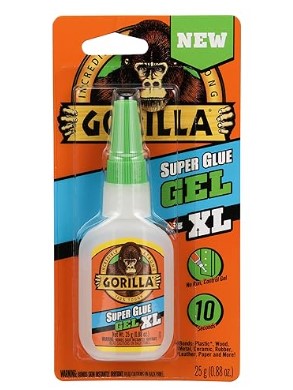
1. Tackle Any Challenge, Inside or Out: Whether you’re a weekend warrior fixing a wobbly chair or a seasoned pro tackling intricate repairs, this glue is your wingman. Its versatility spans across indoor and outdoor projects, holding strong on wood, ceramic, leather, paper, plastic, metal, and even rubber.
2. No Drip, No Drama: Forget messy spills and run-away glue ruining your project. The innovative gel formula stays put, even on vertical surfaces, making repairs cleaner and easier. No more stressing, just precise application and instant bonding.
3. Built to Last, Built to Impress: This isn’t your average quick fix. Gorilla Super Glue Gel XL boasts an anti-clog cap that keeps the glue fresh, ensuring long-lasting performance and impact-tough bonds that resist everyday wear and tear. Your repairs won’t just look good, they’ll be built to endure.
4. Speed Demon, Strength Titan: Time is precious, especially when things break. This glue sets in a lightning-fast 10-45 seconds, eliminating the need for clamps and lengthy drying times. Get back to what matters most, quickly and efficiently.
5. Beyond the Basics: Don’t underestimate its range! This glue goes beyond everyday repairs. Use it for creative projects, crafting, and even outdoor applications where temperature fluctuations might occur (it withstands -65°F to 220°F). Unleash your inner inventor and tackle anything with confidence.
6. Gorilla Super Glue Gel XL: More than just glue, it’s an instant solution for a world of possibilities.
Key Benefits:
- Versatile for indoor & outdoor projects
- No-drip gel formula for precise application
- Anti-clog cap for long-lasting performance
- Impact-tough bonds that resist wear and tear
- Fast-setting (10-45 seconds) & no clamping required
- Wide range of compatible materials
- Withstands temperature fluctuations
2. Scotch Super Glue Gel: Conquer Tiny Disasters with Ease
Life is full of minor mishaps – a chipped mug, a torn leather strap, a loose button. But don’t let these small setbacks ruin your day! Introducing Scotch Super Glue Gel, your pocket-sized hero for quick repairs and lasting solutions.

Strength in Seconds: No more waiting for repairs to set. This gel formula dries lightning fast, creating permanent bonds in seconds. Fix broken eyeglasses, mend torn wallets, or reattach loose trim – all with the speed and efficiency you crave.
Precision at Your Fingertips: Say goodbye to messy drips and gluey fingers. The convenient gel formula stays put, allowing for precise application, even on vertical surfaces. No more wasted glue, just targeted bonding exactly where you need it.
Material Master: This versatile glue isn’t picky. It tackles a wide range of materials, from wood and metal to rubber and vinyl. Fix your favorite ceramic mug, mend leather shoes, or even reattach a broken glass picture frame – the possibilities are endless.
Storage Savior: No more scrambling for misplaced glue. The convenient two-pack ensures you have a fresh tube on hand whenever disaster strikes. Plus, the compact size fits easily in your toolbox or purse, ready for action when needed.
Beyond the Basics: Don’t underestimate its potential! This glue isn’t just for quick fixes. Use it for creative projects, crafting, and even DIY repairs around the house. Unleash your inner inventor and tackle any challenge with confidence.
Scotch Super Glue Gel: More than just glue, it’s your everyday hero for a life less interrupted.
Key Benefits:
- Fast-drying for instant repairs
- Precise application with no-drip gel formula
- Bonds a wide range of materials
- Convenient two-pack for always-ready repairs
- Compact size for easy storage
What Is Superglue Used For?
Here are some common applications where superglue shines:
- Quick repairs: Superglue excels at fixing small cracks, chips, and breaks in various materials like ceramics, metal, plastic, rubber, and leather
- Bonding dissimilar materials: Unlike many glues designed for specific materials, superglue can effectively bond a wider range of materials.
- Securing small parts: Superglue is ideal for attaching small components like beads, jewelry findings, or electronic parts.
- Sealing leaks: It can be used to seal minor leaks in pipes, hoses, or containers (check compatibility with the material beforehand).
How Does Super Glue Work?
Super glue (cyanoacrylate) reacts with moisture (even from the air) to form long chains, creating a strong plastic mesh that binds surfaces together. This rapid curing makes it ideal for quick repairs on various materials.
Read Also Is Wood Glue And Sawdust Stainable : A Guide to DIY Woodworking
What Will Super Glue Not Stick To?
There are several materials it struggles to bond with effectively:
- Non-porous surfaces: Materials like glass, Teflon, and polished metals lack sufficient porosity.
- Oily or greasy surfaces: Oils and grease create a barrier that prevents the glue from adhering properly.
- Wet surfaces: Moisture can prematurely activate the glue, hindering its bonding ability.
- Certain plastics: Some plastics, particularly those with low surface energy like polyethylene (PE) and polypropylene (PP).
- Loose or dusty surfaces: Uneven or crumbly surfaces lack the necessary contact area for the glue to form a strong bond.
- Highly flexible materials
- Food-contact surfaces
What Are The Disadvantages Of Super Glue?
Disadvantages that you should consider before using it:
- Fast setting time: While this can be an advantage for quick fixes, it also leaves limited room for error or adjustments.
- Difficulty in removal: Super glue forms strong, permanent bonds that are challenging to remove once cured.
- Limited gap-filling ability: Super glue works best with tight-fitting joints and minimal gaps.
- Not suitable for flexible applications: It’s not ideal for situations requiring movement or bending in the joint, as it can crack or fail under stress.
- Limited water resistance: Most super glues are not water-resistant and should not be used for outdoor applications.
- Not food-safe: Using it on food-contact surfaces can pose health risks.
How To Remove Super Glue?
Removing super glue can be tricky, but here are some methods to try:
- Acetone (for non-porous surfaces): Soak a cloth and gently dab the glue. Test on an inconspicuous area first.
- Vinegar (safer option): Soak a cloth and apply warm compresses. May require repeated applications.
- Heat (carefully): Apply low heat with a hairdryer to soften the glue, then scrape gently with a plastic tool.
- Commercial removers: Follow product instructions, prioritizing well-ventilated areas and proper protection.
Is Super Glue Heat Proof?
Most have a maximum continuous temperature around -55° to 100° C. For heat-resistant applications, opt for specially formulated “high-temp” super glues.
Is Super Glue Safe On Skin?
Super glue is not safe for skin. It can cause irritation, burns, and even blisters. Avoid skin contact and seek medical attention if it occurs.
Is Super Glue Waterproof?
Most super glues are not waterproof. They are not suitable for outdoor use or areas exposed to moisture. However, specific waterproof super glues are available for applications requiring water resistance.
Is Superglue Long Lasting?
Superglue itself forms strong, long-lasting bonds. However, its shelf life is limited once opened, and it might degrade over time, impacting bond strength.
Is Super Glue Is Flammable?
Yes, super glue (cyanoacrylate) is flammable. It can ignite when exposed to high temperatures or open flames due to its chemical composition.
What Chemical Is Super Glue?
Super glue is primarily composed of cyanoacrylate, a family of strong and fast-acting adhesives.
Why Is Super Glue So Hot?
Super glue gets hot due to the exothermic reaction it undergoes when it comes into contact with moisture. This rapid chemical process releases heat, causing the glue and surrounding area to feel warm or even hot.
Does Toothpaste Remove Super Glue?
While toothpaste contains mild abrasives, it’s generally not an effective method for removing super glue. Its effectiveness is limited, and it might even scratch delicate surfaces.
Can Vinegar Remove Super Glue?
While not as effective as some solvents, vinegar can help loosen super glue due to its mild acidity.
Wood Glue Vs Super Glue For Metal
Neither wood glue nor super glue are ideal choices for bonding metal to metal. Wood glue is specifically formulated for bonding wood, and its adhesive properties are not well-suited for metal surfaces.
While super glue can form strong bonds on various materials, its effectiveness on metal is often limited.
Can I Use Super Glue As Wood Glue?
It’s generally not recommended to use super glue as a substitute for wood glue. While super glue offers strong bonding properties, it has several drawbacks that make it unsuitable for most woodworking applications:
- Limited bond strength on wood
- Brittleness
- Poor gap-filling ability
- Difficulty in removal
- Not water-resistant
When To Consider Super Glue For Wood?
In specific situations, super glue might be a temporary solution for minor wood repairs or quick fixes where:
- The bond is not subjected to significant stress or weight.
- Flexibility is not a crucial requirement.
- A small gap needs filling.
- Disassembling the joint in the future is not necessary.
Which Is Stronger Gorilla Glue Or Super Glue?
Comparing strength directly is complex, as it depends on materials and application. Generally, Gorilla Glue offers stronger long-term bonds for wood, while super glue provides faster, initial bonding on various materials. Choose based on your project’s needs.
Wood Glue Vs Super Glue: Which One To Choose?
Choose wood glue for wood projects: Strong, durable bonds, gap-filling ability, water resistance (options available). Avoid super glue on wood: Brittle, poor gap-filling, not water-resistant (mostly), difficult removal.
FAQs
Is super glue the most powerful glue?
No, super glue is not necessarily the most powerful glue. While it offers strong bonds, specialized adhesives like epoxy or those designed for specific materials can provide superior strength and durability in various applications.
What wood glue is the strongest?
Determining the “strongest” wood glue depends on specific tests and applications, but Titebond III Ultimate and J-B Weld ClearWeld Epoxy generally rank high in terms of tensile strength.
Is wood glue permanent?
While not truly “permanent,” wood glue forms strong, long-lasting bonds that are difficult to break without damaging the wood itself. Its effectiveness depends on proper application and choosing the right type for your project.
Can I use super glue on mirror?
It’s generally not recommended to use super glue on mirrors. Consider specialized mirror adhesives for optimal results.
Which glue is best for everything?
There’s no single “best glue for everything.” Different materials and applications require specific adhesive properties.
Can you use wood glue on other materials?
While wood glue excels at bonding wood, it’s generally not ideal for other materials due to limited adhesion, lack of flexibility, and water solubility. Opt for specific glues designed for each material for optimal results.
What material will wood glue not stick to?
Wood glue generally won’t effectively adhere to non-porous surfaces like metals, plastics, glass, and heavily oiled or waxed wood.
Does wood glue dry with heat?
Wood glue cures primarily through water evaporation, not heat. While warm temperatures can slightly accelerate drying, excessive heat can negatively impact the bond strength and damage the wood.
Why is super glue so good?
Super glue excels in its fast-acting, strong bonds across various materials. It’s ideal for quick repairs, diverse bonding needs, and small parts attachment, making it a versatile tool for various applications.
Is super glue Acrylic?
Super glue, also known as cyanoacrylate, is not technically acrylic. While the main ingredient, cyanoacrylate, is derived from acrylic acid.
Conclusion
So, we are at the end of the hot debate of wood glue vs super glue. The choice between wood glue and super glue depends on the specific requirements of your project. Each adhesive has its own set of advantages and limitations, making them suitable for different applications.
Wood glue, primarily composed of polyvinyl acetate (PVA), is an excellent choice for woodworking projects. On the other hand, super glue, made mainly of cyanoacrylate (CA), is ideal for quick repairs, small fixes, and bonding dissimilar materials.



